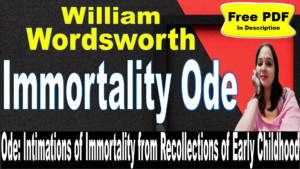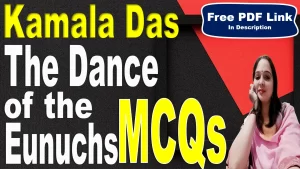Essay Type Questions
Write the critical appreciation of the poem “The Deserted Village” by Oliver Goldsmith.
Introduction
Oliver Goldsmith’s poem “The Deserted Village,” published in 1770, is a poignant reflection on the consequences of rural depopulation due to the rise of urbanization and industrialization. Through vivid imagery and a profound emotional resonance, Goldsmith laments the loss of community, simplicity, and virtue in the face of economic greed and social change. The poem serves as both a celebration of pastoral life and a critique of the societal shifts that lead to the decline of rural settings.
Central Idea
The central idea of “The Deserted Village” revolves around the conflict between the simplicity and charm of rural life and the destructive forces of wealth and luxury that lead to moral decay. Goldsmith contrasts the idyllic beauty of village life with the harsh realities of poverty and societal neglect. Through his reflections, he advocates for the appreciation of natural virtues and communal bonds that are often overshadowed by the pursuit of material wealth.
Structure & Rhyme Scheme
The poem comprises 430 lines, organized into heroic couplets, following an “AABB” rhyme scheme. Each line is written in iambic pentameter, providing a rhythmic flow that enhances the musicality of the poem. This structured form allows Goldsmith to convey his message with clarity and precision, while also giving the poem a formal elegance that reflects the neoclassical conventions of his time.
Theme
The poem explores several interrelated themes:
Nostalgia for Rural Life: Goldsmith expresses a deep longing for the simplicity and community spirit of village life. The poem evokes a sense of loss as the village is abandoned due to the allure of urban wealth.
Critique of Wealth and Luxury: Goldsmith critiques the moral decay associated with wealth and luxury, arguing that they lead to the deterioration of human values and social bonds.
Nature vs. Civilization: The tension between nature and the encroachments of civilization is a recurring theme. Goldsmith suggests that as society advances, it often sacrifices the beauty and harmony found in nature.
Poverty and Inequality: The poem highlights the struggles of the poor, emphasizing the social injustices that arise from economic disparity.
Style
Goldsmith’s style is characterized by a blend of simplicity and elegance. He employs straightforward language and imagery that evoke strong emotional responses. His use of descriptive detail immerses the reader in the setting, creating a vivid picture of the village and its decline. Goldsmith’s ability to articulate complex emotions through accessible language is one of the poem’s strengths, allowing it to resonate with a wide audience.
Poetic Devices
Goldsmith employs various poetic devices to enhance the poem’s emotional impact:
Imagery: Vivid imagery paints a picturesque view of the village and its surroundings, contrasting its former beauty with its current desolation.
Personification: Abstract concepts like despair and anguish are given human qualities, emphasizing the emotional struggles of the characters.
Metaphor and Simile: Goldsmith uses metaphors and similes to draw comparisons that illuminate the poem’s themes, such as likening the village’s decline to a “garden, and a grave.”
Alliteration and Repetition: These devices create musicality and rhythm, reinforcing key ideas and themes throughout the poem.
Symbolism: The village symbolizes lost community and innocence, while urban settings represent greed and moral decay.
Critical Commentary
Many literary critics have lauded “The Deserted Village” for its emotional depth and social commentary. Samuel Johnson, a contemporary of Goldsmith, recognized the poem’s moral seriousness and its critique of societal changes. He praised Goldsmith’s ability to balance pathos with a touch of humor, making the poem both engaging and thought-provoking. Modern critics often highlight the poem’s prescient exploration of rural depopulation and the effects of industrialization, noting its relevance to contemporary discussions about urbanization and environmental degradation.
Message
The poem delivers a powerful message about the importance of valuing simplicity, community, and moral integrity over material wealth. Goldsmith advocates for a return to the virtues of rural life, emphasizing that true happiness lies in human connections and appreciation for nature. He warns against the seductive allure of luxury, suggesting that it ultimately leads to despair and societal disintegration.
Conclusion
In “The Deserted Village,” Oliver Goldsmith masterfully weaves together themes of nostalgia, social critique, and the inherent beauty of rural life. Through its structured form, rich imagery, and poignant emotional depth, the poem serves as both a lament for a lost way of life and a call to recognize the value of simplicity and community. Goldsmith’s exploration of the consequences of wealth and urbanization remains relevant today, making “The Deserted Village” a timeless work that resonates with readers across generations.
Long note on themes used in the poem “The Deserted Village” by Oliver Goldsmith.
Oliver Goldsmith’s poem “The Deserted Village” explores various profound themes that reflect the socio-economic conditions of the 18th century, particularly concerning the rural-urban divide and the impact of industrialization. The primary themes include:
1. Loss and Nostalgia
The theme of loss permeates the poem, as Goldsmith laments the decline of a once-thriving village due to urbanization and the pursuit of wealth. The nostalgic tone is evident as the speaker reminisces about the simplicity, harmony, and virtues of rural life. The village represents an idealized past, filled with community bonds, natural beauty, and genuine happiness. This nostalgia highlights the emotional impact of social changes that uproot communities and alter traditional lifestyles.
2. The Impact of Wealth and Materialism
Goldsmith critiques the effects of wealth on society, illustrating how the pursuit of material riches can lead to moral decay and the destruction of community values. The poem juxtaposes the simplicity of rural life with the excesses of urban society, suggesting that wealth can corrupt human relationships and diminish genuine happiness. Goldsmith argues that while wealth may bring temporary pleasures, it ultimately contributes to social inequality and emotional emptiness.
3. Rural vs. Urban Life
A significant theme in the poem is the contrast between rural and urban life. Goldsmith celebrates the virtues of rural existence—community, hard work, and connection to nature—while criticizing the superficiality and moral decline associated with urban society. The village embodies a lifestyle where individuals live in harmony with one another and their environment, while the city is portrayed as a place of alienation, greed, and despair. This dichotomy serves to highlight the consequences of rapid industrialization and urbanization.
4. Social Inequality and Class Struggle
The poem addresses the growing divide between the rich and the poor, portraying the struggles of the lower class as they are marginalized by the wealthy elite. Goldsmith emphasizes the plight of the peasantry, who are often overlooked in the pursuit of progress and prosperity. Through vivid imagery, he illustrates the hardships faced by the poor while simultaneously critiquing the indifference of the wealthy. This theme underscores the need for social justice and compassion toward those less fortunate.
5. Nature and its Connection to Human Values
Goldsmith uses nature as a backdrop to explore themes of human values and moral integrity. The natural beauty of the village symbolizes peace, contentment, and a way of life that is closely connected to the earth. However, as the village declines, so does the connection to nature, highlighting the adverse effects of urbanization. The poem suggests that a harmonious relationship with nature is essential for human happiness and well-being, and its destruction leads to a loss of essential human values.
6. The Role of the Individual in Society
Goldsmith reflects on the role of individuals within the broader context of society. He portrays characters like the village preacher and the simple farmer, emphasizing their importance in maintaining community values and moral integrity. The poem suggests that every individual has a role to play in fostering a supportive and loving community. The decline of the village represents the loss of these individual contributions, leading to a collective decline in social virtues.
7. The Nature of True Happiness
Throughout the poem, Goldsmith explores the nature of true happiness, contrasting it with the fleeting pleasures offered by wealth and luxury. He asserts that genuine joy stems from simplicity, community, and connection to nature rather than material possessions. This theme encourages readers to reflect on their values and consider what constitutes true fulfillment in life, advocating for a return to simpler, more meaningful ways of living.
Conclusion
In “The Deserted Village,” Goldsmith intricately weaves together themes of loss, nostalgia, wealth, social inequality, nature, and individual roles within society. Through these themes, he critiques the social changes of his time while advocating for the values of community, simplicity, and moral integrity. The poem serves as a timeless reminder of the importance of preserving the virtues that define human connection and happiness amidst the challenges of modernity.










